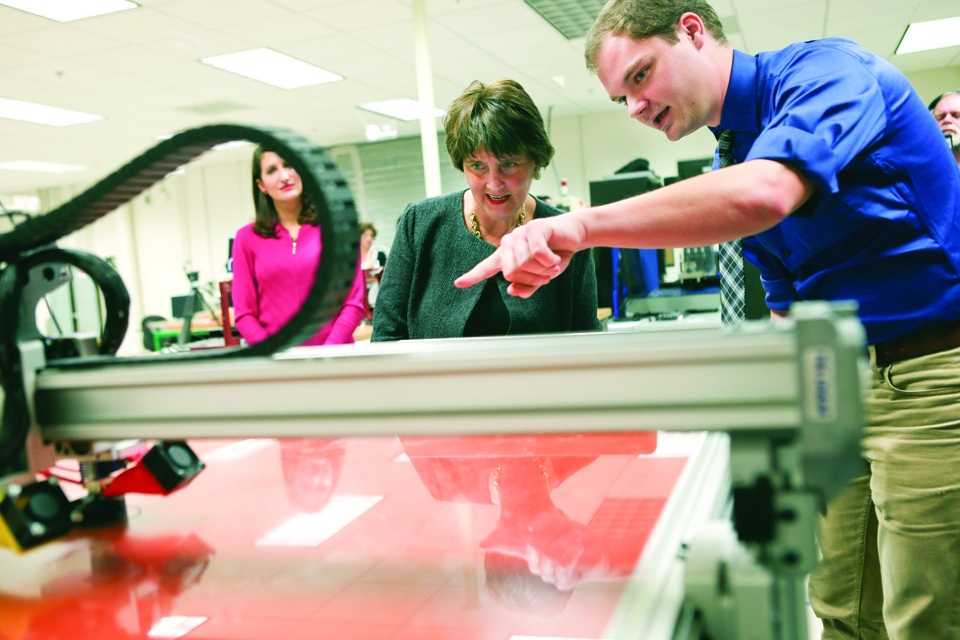

Internship Coordinator Linda Loewer helps a student with her résumé at the Career Services office.
By Seth Culp-Ressler | Features Editor
For most seniors in college, the spring semester of their final academic year is a daunting, stressful time. Finally, after years of having the question “What are you doing after graduating?” pelted at you every holiday break, you actually need an answer.
Coming to some sort of conclusion — i.e., finding a job — can be a harrowing proposition. Unfortunately, there is no magic spell to be found in the next couple hundred words to make the process as effortless as putting off your responsibilities in favor of watching Netflix. Instead, what’s on offer is some practical advice on a task that needs to be done the right way: writing a résumé.
Everybody knows they need a solid résumé in order to score a solid job. Nevertheless, outside some brief and presumably not-that-helpful advice in some high school class, not many people know the important basics when it comes to constructing an impressive collection of experiences and accomplishments.
So, let’s start at the beginning. Your résumé should highlight all of your practical experiences that make you suitable for a job. You’ll want to include details on your education, work experience, volunteer experience and awards or recognitions, for starters. Use lots of active verbs. Keep it to one page. And, since you’re a soon-to-be-graduated college student, drop the high school details if possible. Employers aren’t looking to hire high school kids.
Now, many people will spend a lot of time creating a shiny, up-to-date résumé and proceed to leave it be until more details need to be added. As Duquesne career counselor Coralyn McCauley advises, however, doing so might put students at a distinct disadvantage.
See, a résumé should be just as much of a living, changing document as, say, a cover letter. Serious job applicants would never use the same stock cover letter for more than one position, so don’t do it with a résumé, either.
Instead, tailor your résumé to fit the job being applied to. If a position is heavily focused on writing experience, rearrange your sections to place your examples of those skills at the top. You can even play with creating different categories to allow for moving sections where you’d like.
For example, break a comprehensive block like “Experience” into “Writing Experience” and “Other Experience.” That way, if your writing experience falls further down the page chronologically than less-related details when grouped all together, you can still move the section up.
McCauley also points out that you can tailor your résumé to a company by using the same language they do. If your “stock” résumé uses words like “group,” but the job description uses “team” instead, switch to that language. It shows attention to detail and will catch the application reader’s eye, since it’s a style they are used to working with.
Another benefit of using a company’s own language has to do with a common way résumés are read these days: software. McCauley pointed to Pittsburgh’s own University of Pittsburgh Medical Center (UPMC) as a company that relies heavily on computer programs. Occasionally, UPMC will weed out more than 60 percent of an applicant pool with nothing more than a computer before printing a single résumé. If you use their language, you’re more likely to fall in the favor of their predefined parameters. That means making it to the printer — and that’s a huge boost for your chances.
Even if you get into the hands of hiring personnel, however, there are still some hurdles to overcome. If you’re applying to a larger organization, don’t expect to have your résumé actually read. Instead, chances are that the page chronicling the culmination of your professional life will get nothing more than a seconds-long skim. Depressing, sure, but knowledge of that reality is power.
When someone picks up your résumé, they’ll almost certainly glance along the left side, from top to bottom. You can guess what that means: Bring as much of the important details as you can to the left side of the page, and the especially notable sections should sit somewhere in the top left of the page.
Should everything go well, your clever résumé arrangement will catch their eye, and you’ll be pulled for an interview. Nail that and you at last have an answer to your nagging relatives. If not, no biggie. Get started on the next one. With your newfound résumé writing skills, it should be no problem.




